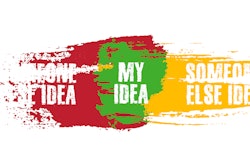Don't use boring titles and do make sure your introduction and list of key points are concise and not too general. These were among the top tips of publishing experts like Prof. Yves Menu, who spoke in a special session at the recent Ukrainian Congress of Radiology.
Speaking via video link, Menu, who is editor in chief of European Radiology, presented his views on what makes a good paper.
"Stick to the rules and start by reading the instructions for authors. Next, make it readable. We never initially reject a paper on the basis of poor English, but you should make an effort to polish the language as much as possible without plagiarism," he said.
"Also, make the text understandable. Ask somebody who is not a specialist in the field to read the manuscript and see if they understand it. Finally check, check, and check again because the devil is in the detail," he told congress attendees listening attentively in Kyiv.
The ultimate goal of every author should be for an article to be read, downloaded, and cited -- not for it to just be published. He noted that the targeted public won't read the article entirely or in a linear manner and it was therefore vital to get key elements right. Authors should focus their efforts on specific sections, he said.
Every reader reads the title, but fewer (70%) read the more complicated abstract, according to Menu. However, 90% read the key points that "showcase" the paper, he noted. If the title and the key points generate enough interest, then they'll download the study but will most likely not read the paper from beginning to end.
"Most will read the introduction ... then commonly will jump to the first paragraph of the discussion or even to the conclusion and the images. This is why we insist on the fact that the introduction should be correct and the first paragraph of the discussion should give real insight into the results of your study," he said.
"It's a bit disappointing but it is a reality; people don't read the materials and methods or the results," Menu pointed out.
Publishing pitfalls
Menu listed common errors for authors to avoid, not just for journal acceptance but also to hook readership:
- The first error is boring titles. Authors must find an attractive catchy title to draw in the reader.
- The second mistake is to list key points that are too general and that are of no interest to anyone. Key points should showcase the quality of both the journal and the article and draw attention to what readers will learn.
- Third, introductions that are much too long and too general should be avoided. Instead, introductions should focus on the reason why a study has been undertaken and what the authors expect as a result.
- A fourth common error is confusion between the 'Materials & Methods' and the 'Results'. For example, the description of the population with inclusion and exclusion criteria should be placed in the former section, and not the latter.
Furthermore, discussions should not be overly long, and the conclusion must be supported by the results, rather than simply reflecting the wishes of the authors. Another error to avoid is wrong and poor citations, as well as substandard images and captions.
Menu told authors to follow the journal's guidelines, with linguistic simplicity and clarity being the priorities. He warned them to be careful about which journals they published in and to watch out for predatory journals who will certainly publish their paper but also take their money.
Keep it simple
While authors should scrutinize their introduction and discussion sections, care and attention should also be given to the middle parts, participants learned.
"You can have the best introduction and discussion in the world but regardless of how brilliant your study hypothesis, and your rhetorical capabilities are, there is limited likelihood of success if you do not convincingly prove the reproducibility of your results, and if you don't present them as clearly, concisely, completely and correctly as the scientific community expects you to, to support study hypothesis," noted European Radiology deputy editor, Dr. Rossano Girometti.
During the congress session, Girometti and Dr. José M. García Santos from Murcia in Spain (the deputy editor of European Radiology who is in charge of neuroradiology articles) spoke about the essentials of writing for radiology journals.
European Radiology recently released new manuscript requirements and instructions for authors that can be found on the journal website. In January 2023, the journal switched to a single-blinded peer review process, where manuscripts sent to reviewers will no longer be anonymized or blinded, but reviewers’ names will continue to be unknown to authors.
When describing imaging protocol, imaging analysis and standard of reference, authors needed to prove that their setup was robust enough to be repeated in their own setting (repeatability) and more importantly by other researchers (reproducibility), according to Girometti, who is associate professor of radiology at Udine University Hospital, Italy, and an active and longstanding member of the AuntMinnieEurope.com editorial advisory board.
This can be achieved by detailing a reasonable amount of the technical details of the examination, such as equipment, acquisition parameters, and contrast, showing that qualified readers provided image analysis via easy-to-follow interpretation criteria and that there was a robust "ground-truth" to classify cases, he explained.
"Do not provide descriptions of statistical methods, these are too dry or too redundant and complicated. Both will convince readers that Mark Twain was right. There are lies, damn lies, and statistics! Readers will see you are using statistics to build your results rather than analyzing results correctly," he said, noting that authors simply need to say which statistical method is used and when.
He urged would-be authors to organize their results tidily. This meant presenting data in short paragraphs with headings, and in the same order as mentioned in the materials and methods section. He stressed that methods should not be repeated or introduced in the results section. Nor should the results contain interpretation.
"Results are just numbers. Don't assume that results are more credible the more you write," Girometti noted. "Sentences should be short and explain one concept at a time and focus on what is strictly relevant in the study. Tables of data can be more self-explanatory than many lines of text. Remember that secondary information can be moved to 'Supplementary Materials.' "
Finally, don't forget to share your source data, particularly in AI studies, he said.
Q&A discussion
Moderator and session organizer Dr. Uliana Pidvalna, associate professor in the department of normal anatomy at Danylo Halytsky at Lviv National Medical University, said that Ukraine is an emerging country for scientific publications in radiology. "What tips could the presenters specifically offer Ukrainian authors?" she asked.
The first step is always the most difficult, noted Menu. He nodded to pertinent ideas raised by fellow speaker and junior deputy editor Dr. Osman Öcal from Munich, who covered research essential and issues related to starting out in low-cost research programs.
Editorials about papers usually briefly describe why the paper is good, its limitations and what can be done going forward, Menu said. These editorial recommendations can provide potential authors with ideas for a prospective paper. Another possibility is contacting other teams, he said:
"Many papers -- particularly about AI or radiomics -- fail to provide external validation. If you feel you have enough relevant types of patients at your institute, you can propose using your resources to validate retrospective single-center studies. This would be extremely valuable and an easy way to get involved in publications and there are hundreds of opportunities for that," Menu said.
"You need to have suitable patients in the topic, and a willingness to contact the other teams and build multicentric studies," he pointed out.
Returning to the question of language, Pidvalna asked whether nonnative speakers should write in their own language and then translate it or write directly in English.
Menu prefers an article written directly in English even with grammar mistakes because of the risk of potential errors introduced by online translation tools. He noted that a paper written in imperfect but simple and understandable English can always be linguistically improved in later revision steps. However, if a paper is incomprehensible due to automatic translation, it will be rejected.
"New AI tools will most likely improve translations but authors must be careful of confidentiality issues if using tools like ChatGPT and should avoid using it for the materials and methods and results sections," he said.
The Ukrainian Congress of Radiology was held from 19 to 21 October. Among the other overseas speakers were Dr. Felico D’Arco from London, Dr. Helmut Prosch from Vienna, Prof. Apostolos Karantanas from Crete, Prof. Adrian Brady from Cork, Ireland, Prof. Donald Resnick from San Diego, U.S., Prof. Mehmet Cem Calli from Izmir, Turkey, Dr. Dennis Bielecki from London, Dr. Ali Yikilmaz from Hamilton, Ontario, Canada, Prof. Andrew Demchuk from Calgary, Canada, Dr. Nataliya Kovalchuk from Stanford, U.S., and Prof. Reto Bale from Innsbruck, Austria.


















